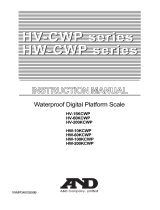
AD4412-CW 3
This section shows descriptions from connection to basic settings for using the AD-4412-CW as a weight checker.
Setting flow Instruction manual
“ ” shows the instruction
manual section referenced..
Connecting
Setting the weighing unit, decimal
point position and division
Connecting to external
equipment
Connecting to the indicator
Setting the weighing capacity
Adjusting the weight
Setting the conveyer length
Configuring settings
for theproducts
Setting the speed
Configuring settings
for the indicator
Setting the photo eye sensor
Setting the detect basis
Setting the product length
Refer to "3. Installing the
Weighing Indicator" for
details of connection.
Refer to "11. Interface" for
other external equipments.
Refer to "6.1. Calibrating the
Indicator using a Weight",
"9.12.Weighing" and "9.13.
Cal (Calibration)" for details
of scale settings.
Refer to "5.6.4. Setting the
Digital Output (DO)",
"9.4.DO Map (Digital Output
Map)" and "9.5.Control I/O
(Part of Digital Output) " for
details of DO settings.
Refer to "9.18.Control I/O
(Part of Digital Input)" for
details of DI settings.
Refer to "9.1. Product name/
product code" to "9.7. Tare"
for details of product settings.
Refer to "5.6.2. Settings of
Threshold Values ( Target,
HiHi Limit, Hi Limit, Lo Limit,
LoLo Limit )" and
"9.2. Detect basis" for
details of detect basis.
Setting the DO and DI





























